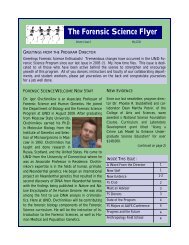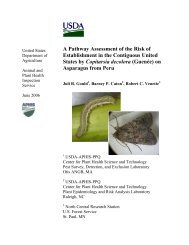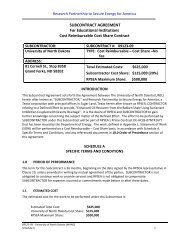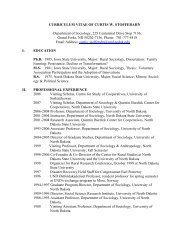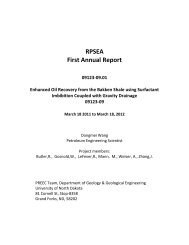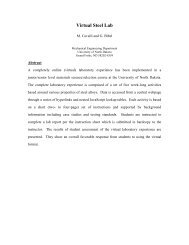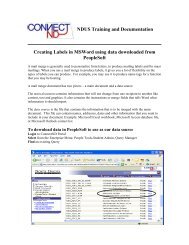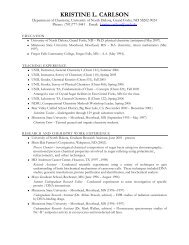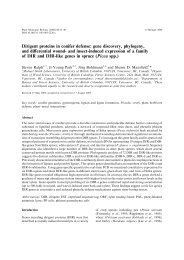Predicting Invasiveness of Plant Species Based on Biological ...
Predicting Invasiveness of Plant Species Based on Biological ...
Predicting Invasiveness of Plant Species Based on Biological ...
Create successful ePaper yourself
Turn your PDF publications into a flip-book with our unique Google optimized e-Paper software.
Goodwin et al. Invasive versus N<strong>on</strong>invasive <str<strong>on</strong>g>Plant</str<strong>on</strong>g>s 425<br />
Geographic range is probably correlated with several<br />
biological attributes <str<strong>on</strong>g>of</str<strong>on</strong>g> species because, presumably, biological<br />
attributes permit a species to occupy a large<br />
range (Crawley 1987). We found a significant, positive<br />
correlati<strong>on</strong> between range and flowering period (r <br />
0.29, p 0.0001) but no significant correlati<strong>on</strong> between<br />
range and the other characteristics. There are probably<br />
other, less comm<strong>on</strong>ly available biological attributes that<br />
are correlated with range.<br />
It has been argued (Daehler & Str<strong>on</strong>g 1993; Lodge<br />
1993b) that inexpensive, easily c<strong>on</strong>ducted research be<br />
used to predict invasiveness in order to prioritize more<br />
costly research up<strong>on</strong> invading species. Previous models<br />
or systems for determining invasiveness require data<br />
that are restricted to more intensively studied species or<br />
genera (Smallwood & Salm<strong>on</strong> 1992; Tucker & Richards<strong>on</strong><br />
1995; Rejmánek & Richards<strong>on</strong> 1996) and that may<br />
be useful for predicting the invasiveness <str<strong>on</strong>g>of</str<strong>on</strong>g> intenti<strong>on</strong>ally<br />
introduced species within those groups (e.g., Perrins et<br />
al. 1992; Reichard & Hamilt<strong>on</strong> 1997). Because such informati<strong>on</strong><br />
is not available for many species, however, it<br />
is not useful for predicting the invasiveness <str<strong>on</strong>g>of</str<strong>on</strong>g> accidentally<br />
introduced species.<br />
The importance <str<strong>on</strong>g>of</str<strong>on</strong>g> geographic range in predicting invasiveness<br />
suggests that predicti<strong>on</strong> <str<strong>on</strong>g>of</str<strong>on</strong>g> invasiveness <strong>on</strong> a<br />
species-by-species basis is not likely to help stem the<br />
flow <str<strong>on</strong>g>of</str<strong>on</strong>g> accidentally introduced invasive species. The<br />
species that are likely to be inadvertently picked up and<br />
moved to a new locati<strong>on</strong> due to their wide distributi<strong>on</strong><br />
are the same species that are likely to succeed in a new<br />
envir<strong>on</strong>ment due to their wide envir<strong>on</strong>mental tolerances.<br />
Stringent, universally applied measures will be required<br />
to curtail these invasi<strong>on</strong>s.<br />
Acknowledgments<br />
We thank A. Morin, S. Findlay, and three reviewers for<br />
comments <strong>on</strong> an earlier versi<strong>on</strong> <str<strong>on</strong>g>of</str<strong>on</strong>g> this paper. This research<br />
was supported by a scholarship from the Natural<br />
Sciences and Engineering Research Council <str<strong>on</strong>g>of</str<strong>on</strong>g> Canada<br />
(NSERC) to B.J.G., an NSERC research grant to L.F., and<br />
Carlet<strong>on</strong> University.<br />
Figure 1. The probability <str<strong>on</strong>g>of</str<strong>on</strong>g> plant species being invasive<br />
( P( I)) against European geographic range (see<br />
Methods for a descripti<strong>on</strong> <str<strong>on</strong>g>of</str<strong>on</strong>g> how range was measured).<br />
The data for the 110 pairs <str<strong>on</strong>g>of</str<strong>on</strong>g> invaders ( P( I) <br />
1) and n<strong>on</strong>-invaders ( P( I) 0) are plotted as means<br />
(boxes) and standard errors (vertical lines) for each<br />
range interval. The equati<strong>on</strong> from the sec<strong>on</strong>d logistic<br />
model (involving <strong>on</strong>ly range, Table 1) is also plotted<br />
(curve).<br />
Literature Cited<br />
Baker, H. G. 1965. Characteristics and modes <str<strong>on</strong>g>of</str<strong>on</strong>g> origin <str<strong>on</strong>g>of</str<strong>on</strong>g> weeds. Pages<br />
147–172 in H. G. Baker and G. L. Stebbins, editors. The genetics <str<strong>on</strong>g>of</str<strong>on</strong>g><br />
col<strong>on</strong>izing species. Academic Press, New York.<br />
Baker, H. G. 1986. Patterns <str<strong>on</strong>g>of</str<strong>on</strong>g> plant invasi<strong>on</strong>s in North America. Pages<br />
44–57 in H. A. Mo<strong>on</strong>ey and J. A. Drake, editors. Ecology <str<strong>on</strong>g>of</str<strong>on</strong>g> biological<br />
invasi<strong>on</strong>s <str<strong>on</strong>g>of</str<strong>on</strong>g> North America and Hawaii. Springer-Verlag, New<br />
York.<br />
Baruch, Z., M. M. Ludlow, and R. Davis. 1985. Photosynthetic resp<strong>on</strong>ses<br />
<str<strong>on</strong>g>of</str<strong>on</strong>g> native and introduced C4 grasses from Venezuelan savannas.<br />
Oecologia 67:388–393.<br />
Caldwell, M. M., J. H. Richards, D. A. Johns<strong>on</strong>, R. S. Nowak, and R. S.<br />
Dzurec. 1981. Coping with herbivory: photosynthetic capacity and<br />
resource allocati<strong>on</strong> in two semiarid Agropyr<strong>on</strong> bunchgrasses.<br />
Oecologia 50:14–24.<br />
Caldwell, M. M., T. J. Dean, R. S. Nowak, R. S. Dzurec, and J. H. Richards.<br />
1983. Bunchgrass architecture, light intercepti<strong>on</strong> and water<br />
use efficiency: assessment by fibre optic point quadrats and gas exchange.<br />
Oecologia 59:178–184.<br />
Clutt<strong>on</strong>-Brock, T. H., and P. H. Harvey. 1991. Comparative approaches<br />
to investigating adaptati<strong>on</strong>. Pages 7–29 in J. R. Krebs and N. B.<br />
Davies, editors. Behavioural ecology: an evoluti<strong>on</strong>ary approach.<br />
Blackwell Scientific Publicati<strong>on</strong>s, Oxford, United Kingdom.<br />
Crawley, M. J. 1986. The populati<strong>on</strong> biology <str<strong>on</strong>g>of</str<strong>on</strong>g> invaders. Philosophical<br />
Transacti<strong>on</strong>s <str<strong>on</strong>g>of</str<strong>on</strong>g> the Royal Society <str<strong>on</strong>g>of</str<strong>on</strong>g> L<strong>on</strong>d<strong>on</strong> B 314:711–731.<br />
Crawley, M. J. 1987. What makes a community invasible? Pages 429–<br />
453 in A. J. Gray, M. J. Crawley, and P. J. Edwards, editors. Col<strong>on</strong>izati<strong>on</strong>,<br />
successi<strong>on</strong> and stability. Blackwell Scientific Publicati<strong>on</strong>s,<br />
Oxford, United Kingdom.<br />
Crawley, M. J. 1989. Chance and timing in biological invasi<strong>on</strong>s. Pages<br />
407–424 in J. A. Drake, H. A. Mo<strong>on</strong>ey, F. di Castri, R. H. Groves,<br />
F. J. Kruger, M. Rejmánek, and M. Williams<strong>on</strong>, editors. <strong>Biological</strong><br />
invasi<strong>on</strong>s: a global perspective. John Wiley & S<strong>on</strong>s, New York.<br />
Daehler, C. C., and D. R. Str<strong>on</strong>g Jr. 1993. Predicti<strong>on</strong> and biological invasi<strong>on</strong>s.<br />
Trends in Ecology and Evoluti<strong>on</strong> 8:380.<br />
di Castri, F. 1990. On invading species and invaded ecosystems: the interplay<br />
<str<strong>on</strong>g>of</str<strong>on</strong>g> historical chance and biological necessity. Pages 3–16 in<br />
F. di Castri, A. J. Hansen, and M. Debussche, editors. <strong>Biological</strong> invasi<strong>on</strong>s<br />
in Europe and the Mediterranean Basin. Kluwer Academic<br />
Publishers, Dordrecht, The Netherlands.<br />
Ewel, J. J. 1986. Invasibility: less<strong>on</strong>s from South Florida. Pages 214–230<br />
in H. A. Mo<strong>on</strong>ey and J. A. Drake, editors. Ecology <str<strong>on</strong>g>of</str<strong>on</strong>g> biological invasi<strong>on</strong>s<br />
<str<strong>on</strong>g>of</str<strong>on</strong>g> North America and Hawaii. Springer-Verlag, New York.<br />
Fox, M. D., and D. Adams<strong>on</strong>. 1986. The ecology <str<strong>on</strong>g>of</str<strong>on</strong>g> invasi<strong>on</strong>s. Pages<br />
235–255 in H. F. Recher, D. Lunney, and I. Dunn, editors. A natural<br />
legacy: ecology in Australia. 2nd editi<strong>on</strong>. Pergam<strong>on</strong> Press, Sydney.<br />
Gray, A. J. 1986. Do invading species have definable genetic characteristics?<br />
Philosophical Transacti<strong>on</strong>s <str<strong>on</strong>g>of</str<strong>on</strong>g> the Royal Society <str<strong>on</strong>g>of</str<strong>on</strong>g> L<strong>on</strong>d<strong>on</strong> B<br />
314:655–674.<br />
C<strong>on</strong>servati<strong>on</strong> Biology<br />
Volume 13, No. 2, April 1999





